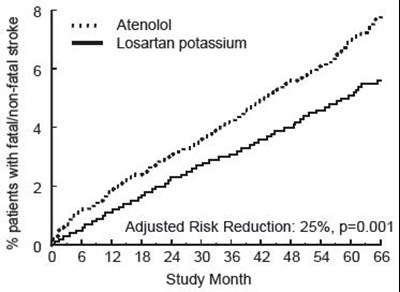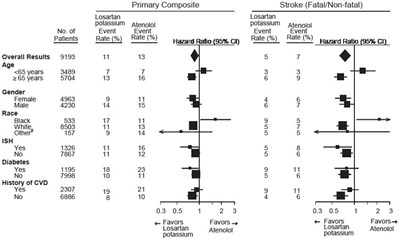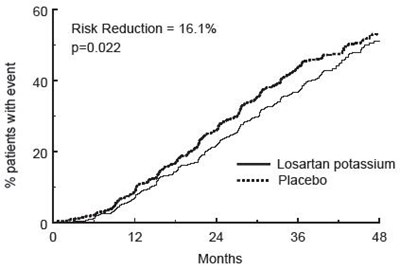Product Images Losartan
View Photos of Packaging, Labels & Appearance
Product Label Images
The following 6 images provide visual information about the product associated with Losartan NDC 50090-2908 by A-s Medication Solutions, such as packaging, labeling, and the appearance of the drug itself. This resource could be helpful for medical professionals, pharmacists, and patients seeking to verify medication information and ensure they have the correct product.
Figure 2 - losartan 03

This figure shows the percentage of patients with fatal or non-fatal stroke. There is no data available for the Atenolol treatment group. The Losartan potassium treatment group had an adjusted risk reduction of 25% with a p-value of 0.001. The study was conducted over a period of 66 months with data points recorded at 6-month intervals.*
Figure 3 - losartan 04

This appears to be a statistical report comparing the effectiveness of Losartan potassium and atenolol in reducing the incidence of stroke, fatal and non-fatal, among patients with diabetes and a history of CVD. The study involved 9193 patients under the age of 65, with 3489 females and 5704 males. Other demographic characteristics such as ethnicity/race are not available. The table presents data on the number of patients with particular health conditions such as hypertension and diabetes and the rate of occurrence of events under each medication. The Hazard Ratio with 35% CI indicates the probability of one medication being more effective than the other.*
Figure 4 - losartan 05

This appears to be a table showing the percentage of patients with an event and some statistics related to a study that compared losartan potassium to placebo over the course of 48 months. The table shows that 60% of patients on losartan potassium had an event compared to 40% of patients on placebo. The risk reduction is calculated to be 16.1%, with a p-value of 0.0022.*
* The product label images have been analyzed using a combination of traditional computing and machine learning techniques. It should be noted that the descriptions provided may not be entirely accurate as they are experimental in nature. Use the information in this page at your own discretion and risk.


